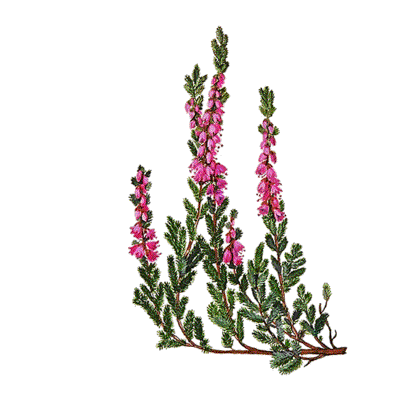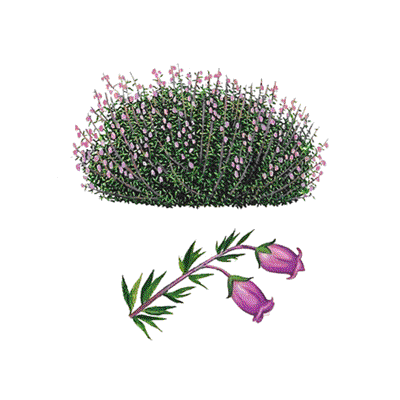![]()

![]()

Calluna vulgaris
We have all heard of heather. We have probably all seen heather. But look it up in a plant encyclopedia and you will find that there is no such plant. Instead, you will be invited to look up three other plants - Calluna, Erica and Daboecia. Heather is a collective name which is used to refer to all of these different genera of plants which to you and me look very much alike, yet to the botanist are quite separate. The best known in Great Britain, because it occupies such large tracts of land from the New Forest to the north of Scotland, is Calluna vulgaris, the ling or heather of the moors. It is also the smallest genus, having only one species (though there are a lot of varieties of this one species). The name Calluna is actually derived from a Greek word meaning 'clean', probably a reference to the use of ling stems for making brooms or besom.
Ling, Calluna vulgaris, in the language of flowers, is a symbol of solitude. Aptly so, for this small yet durable shrub shares its habitat with alpine flowers, in places where human intrusion is the exception. Ling inhabits a terrain which is harsh in climatic terms and not over-rich in plant food. A typical moorland soil consists of acid peat which forms under conditions of high rainfall and a short growing season. Dead plant material accumulates quicker than the organisms in the soil can break it down, and so the partially decomposed material builds up into layers of what we call peat. The ling has only been cultivated as a garden plant since early in the nineteenth century. It is possible that this is due to the firmly held conviction that ling would not grow when uprooted from the fells which it covers so luxuriantly in the wild. Highlanders and many north countrymen still consider that good fortune comes to those who find a patch of white heather. Life has never been easy for those living in 'ling land', for the shallow, acid soil in which it grows so well yields no more than a subsistence living to anyone who tries to farm there, and great use had to be made of any materials lying ready to hand. Like heather. Heather was used for roofing: its stems were twisted into ropes to secure thatch against gale force winds. The stiff, hard stems could be fashioned into serviceable brooms or besoms by lashing them to handles made from coppiced hazel. And there were lots of other uses as well. The Picts made beer from ling. Unfortunately, the secret manufacturing process was never divulged to strangers, and when this most mysterious race was dispersed the secret was lost. Fresh flowering shoots can be used in the treatment of kidney infections, as an antiseptic, diuretic and cleansing mixture. In addition, ling contains tannin for curing leather and a yellow dye for colouring wool. It was also used as a fuel to heat a bread oven. All things considered, heather was an important constituent of the upland economy. More significantly, it is an important fodder crop for sheep, deer and grouse, and is 'farmed' as such by the shepherds of the moors. Old plants will, in time, grow tall and woody, producing few young shoots suitable for grazing, but the farmers ensured a constant supply of young shoots and a complete rejuvenation of the heather crop by burning off sections of the moor each year.
In spite of growing under very specialised conditions of soil and climate, Calluna will adapt to a wide variety of soils in garden cultivation with one notable exception. It will not thrive in a lime soil, no matter how much effort and expensive mulching of peat or watering with trace elements are lavished on their cultivation. Given an acid or neutral soil, rich in humus, Calluna vulgaris in all the many forms available, ranging from low-creeping plants to shrubs a metre or more in height, will prove easy to grow. The most suitable soil is one which has been well-prepared with dressings of peat or leaf mould, and is not liable to waterlogging in winter or excessive drying out in summer. It flowers in summer and autumn, though there are varieties available with coloured foliage, which extends the interest over much of the year.
Erica is a bit different to Calluna. There are at least five hundred species of Erica. Of these no less than four hundred and seventy grow naturally in South Africa. Several more species inhabit tropical and North Africa, and Europe lays claim to those that remain. Five species are generally accepted as being indigenous to Britain and Ireland, though they may have been introduced by the Romans. The botanical difference between Calluna and Erica is easily discovered by looking at the flower. In Calluna, the calyx (that's the outer protective part of a flower) is enlarged and coloured to become the ornamental part of the flower. The Erica is traditional in formation having the calyx green and the corolla as the coloured portion.

Daboecia Cantabria
The third genus, Daboecia, is of more manageable size, having just two species, closely allied to, and needing the same soil conditions as Calluna and Erica. Saint Dabeoc's heath, Cantabrian heath, or Irish wort, the Daboecia of botanists is named after one of Ireland's many saints, St. Dabeoc. Unfortunately, someone mis-spelled this rather obscure saint's name by transposing the 'e' and 'o', so Dabeocia became Daboecia. The individual egg-shaped flowers, which appear from late summer to early autumn, are larger than those of the other heathers.
In an over-rich soil heathers put on a lot of vegetative growth at the expense of flowers, so, apart from an annual mulch of peat, any supplementary feeding must be done with care. Trimming of the old flower stems annually will prevent the plants growing leggy and untidy. If this is done in spring, just before new growths break, they will make well-furnished compact shrubs. Starting from the top, a typical heather shoot consists of a fresh green-growing tip, then the flowers clustered round the stem, and below the flowers more green foliage. Clipping should be done so as to remove all this shoot, including tip and dead flowers, just into the green foliage below the old flower stems. Left unpruned, the green tip above the flowers grows ever upwards while the stem below develops into a 'trunk' devoid of leaves or branches.
In most cases planting is best carried out in the spring. Make a hole deep enough to accommodate the roots comfortably without constricting them in any way. The finished level should leave the junction between root and stems buried about one inch (2.5 cm) below the soil surface. A mulch of peat after planting will additionally encourage roots to develop from the buried stems, giving an altogether stronger feeding area.
Happy gardening.
Bill Hutchings
![]() Return to the February 1999 Features page
Return to the February 1999 Features page
![]() return to Home page and main index
return to Home page and main index
page last updated 1 FEBRUARY 1999